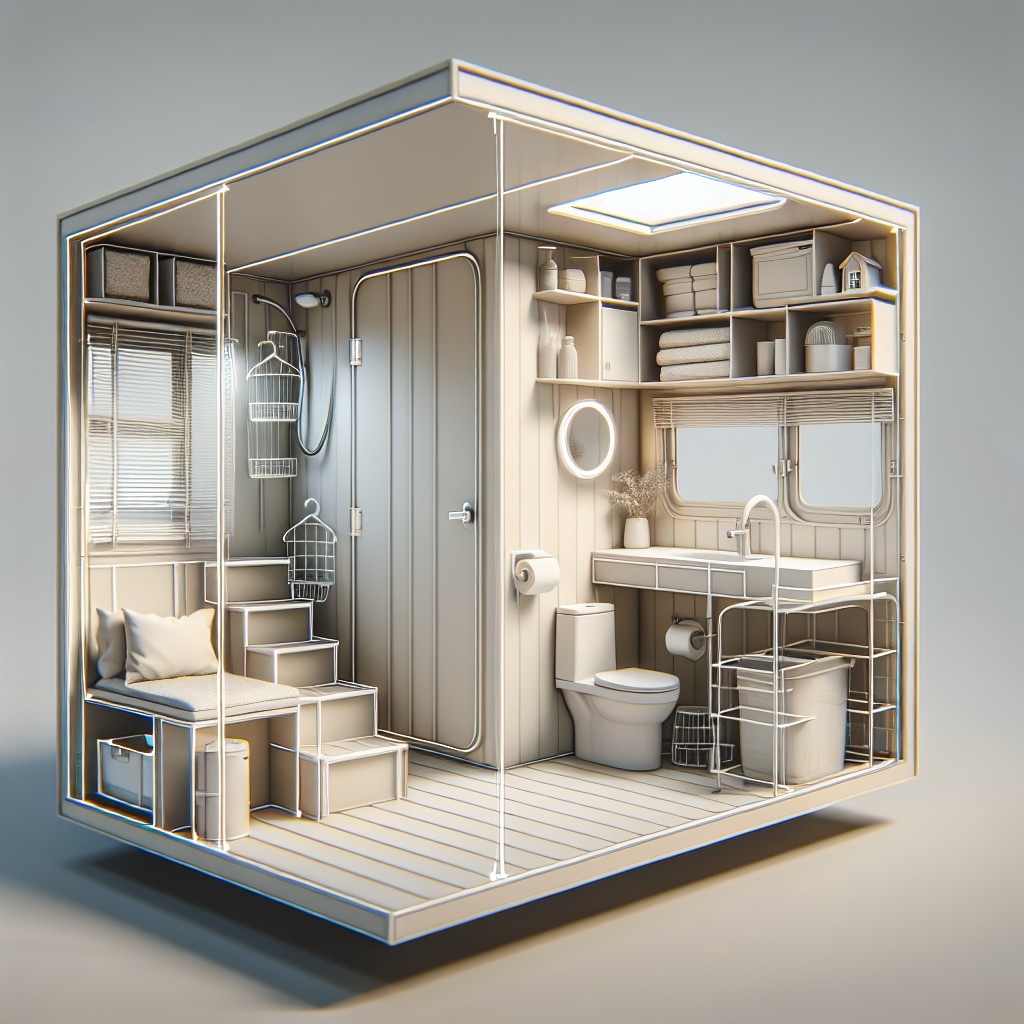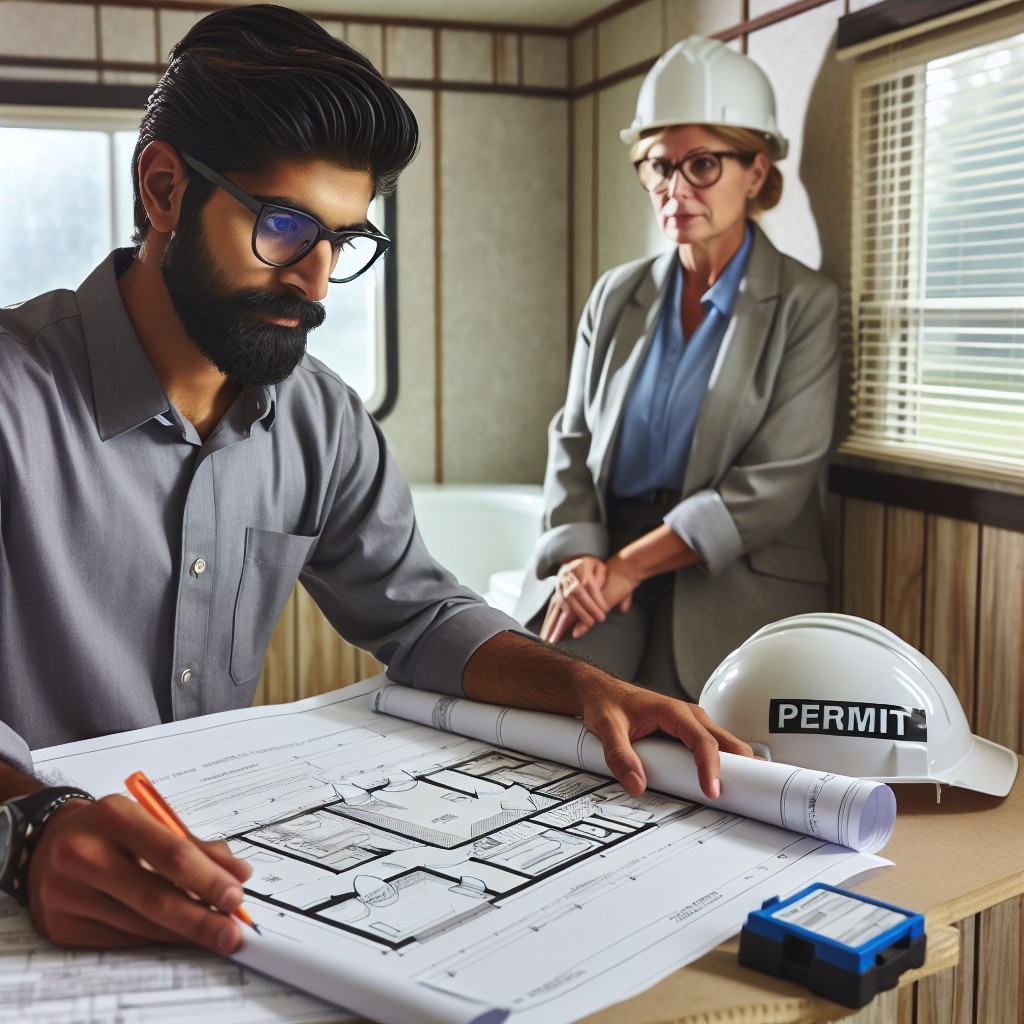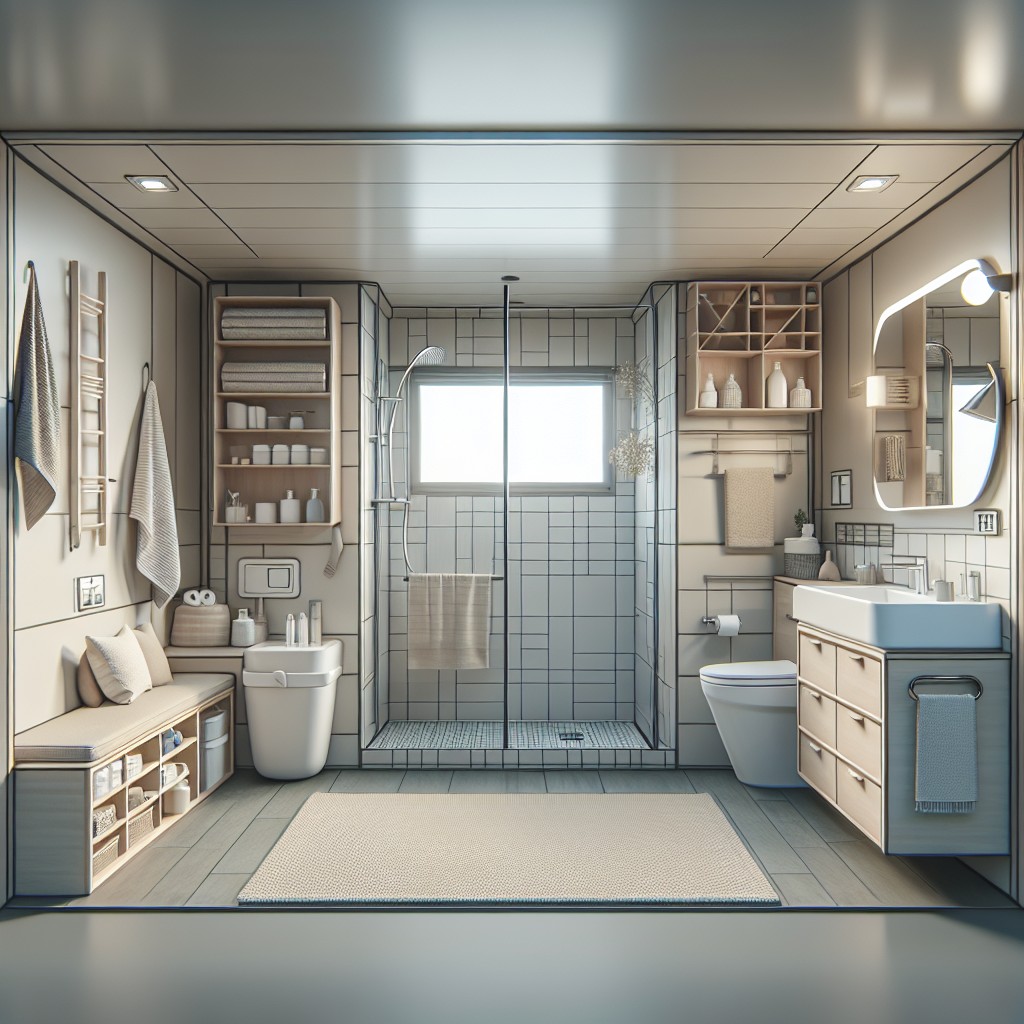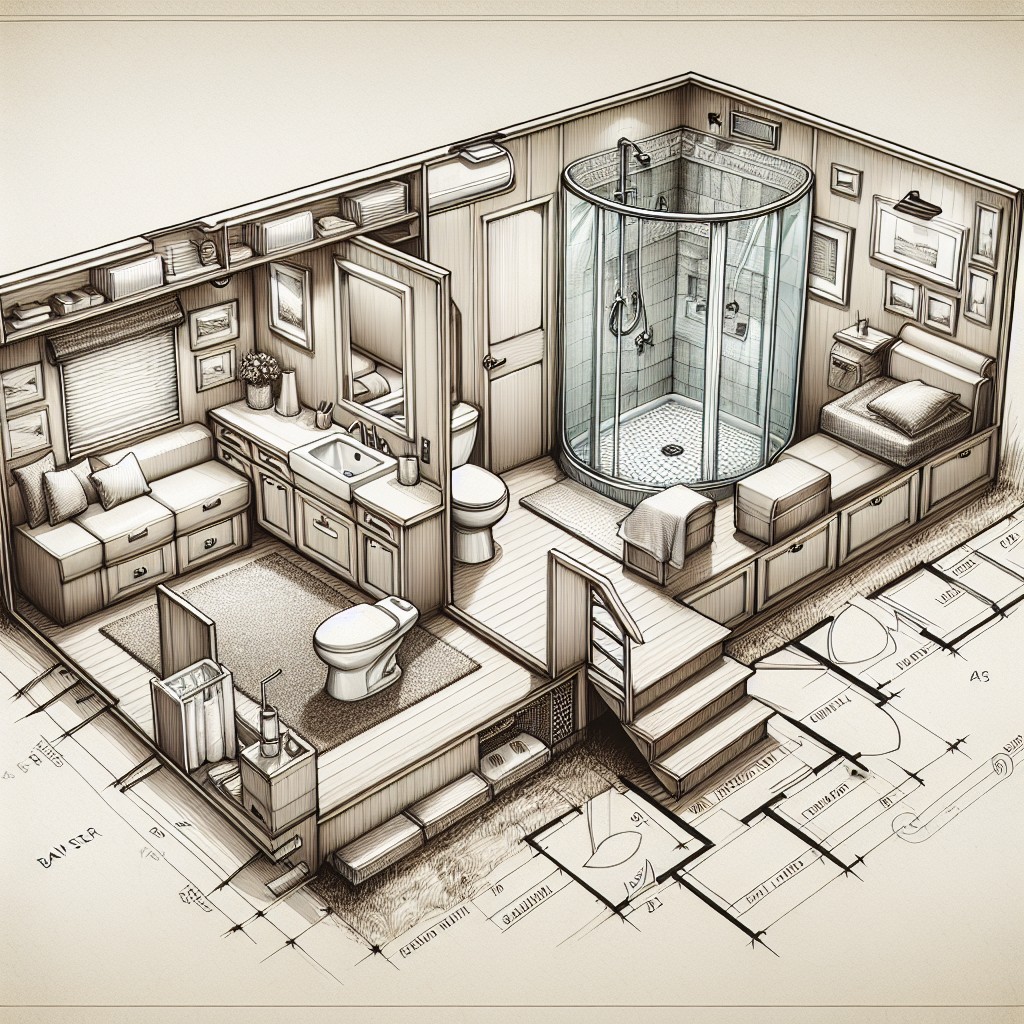Last updated on
Adding a bathroom to a mobile home can revolutionize your living conditions because it increases convenience and home value, which is what we’ll explore today.
Adding a bathroom to a mobile home can seem challenging, but it is entirely feasible with proper planning and execution. This article will guide you through the step-by-step process of how to enlarge your living space effectively and sustainably; discussing everything from finding the right spot in your mobile home, dealing with plumbing, choosing eco-friendly materials, to complying with necessary building codes.
Whether you’re a DIY enthusiast or planning to hire professionals, understanding these key aspects can ensure a smooth project that enhances your home.
There are beneficial details waiting to be unearthed as you dig deeper into this article!
Key takeaways:
- Securing permits and understanding regulations is crucial.
- Consider financing and insurance implications before starting the project.
- Plan the location and size of the bathroom carefully.
- Choose fixtures and features that maximize space and efficiency.
- Use high-quality, moisture-resistant materials for durability.
Considerations Before Adding a Bathroom to a Mobile Home

Embarking on a bathroom addition requires careful preparation. Start by securing the necessary permits; local building codes dictate the specifications for construction projects, so contact your local municipality. This step ensures safety standards are upheld and avoids legal complications.
Additionally, consider the financial aspects. Consult with your insurance provider to understand how modifications could affect your coverage. Changes to your mobile home might necessitate policy updates to protect your investment.
Familiarize yourself with mobile home regulations regarding additions. Some jurisdictions have specific requirements for mobile homes, so it’s crucial to know these details early on to design a project that complies with all guidelines. This foundational knowledge paves the way for a smoother addition process, ultimately leading to the successful expansion of your living space.
Permits and Inspections

Securing the necessary permits should be your initial step, ensuring your project adheres to local codes and standards. Contact your local zoning office to inquire about specific requirements; they can guide you through the process and inform you if your plans meet the zoning regulations for mobile homes.
The inspection process is integral to your project, serving as a checkpoint for safety and compliance with construction codes. Schedule inspections at various stages: after installing rough plumbing but before insulating and closing walls, and once the addition is complete to verify everything is up to code.
Remember that regulations can vary significantly depending on your location. Some areas may have stricter rules for mobile homes compared to traditional houses, especially regarding how additions connect to the existing structure. Stay proactive in your communications with local authorities throughout your project to ensure a smooth and compliant upgrade to your home.
Financing and Insurance

When embarking on a bathroom addition, it’s crucial to consider how this home improvement will impact your finances and insurance coverage. Adequately funding your project ensures that it progresses smoothly, while reviewing and possibly updating your insurance policy safeguards your investment.
Funding options for your renovation include using savings, applying for a home improvement loan, or exploring mobile home equity lines of credit. It’s wise to compare interest rates and terms from different lenders to secure a deal that aligns with your financial situation.
Insurance should not be overlooked; inform your provider about the planned addition. This change may alter your policy premium as it increases the value and replacement cost of your home — but it will also ensure you’re covered in case of damage or loss during and after construction. Always discuss potential changes in your insurance policy upfront to avoid unexpected lapses in coverage.
Regulations

Navigating the regulatory landscape is a critical step in your project. Start by consulting your local building authority to understand specific codes and standards that apply to mobile home additions. These will often address:
- Zoning laws: Determine if your property is zoned for the type of construction you’re planning.
- Building codes: Ensure your addition meets state or local residential building codes, which cover aspects like electrical wiring and plumbing requirements.
- Manufactured home regulations: Mobile homes must comply with the HUD Code, so any addition should align with its standards for safety and construction.
- Setback requirements: Check the minimum distance your addition must be from property lines.
- Mobile home park rules: If your mobile home is within a park, adhere to their regulations which may include limitations on size and exterior aesthetics.
Remember, compliance is non-negotiable. It safeguards both the quality and legality of your new bathroom addition.
Planning Your Bathroom Addition

When plotting out the new bathroom, the size should take both comfort and functionality into account. Too large may become a spatial oddity in a mobile home, while too small may leave users feeling cramped.
The optimal location typically adjoins existing plumbing to ease integration, which often means situating near the kitchen or an existing bathroom to minimize pipe runs.
Considering cost early prevents overextension – this involves not just the build but also the potential rise in utility bills due to additional water and electrical use.
Always anticipate a contingency of at least 10-15% over the estimated budget for unforeseen expenses to ensure a smooth project flow.
Size
When determining the dimensions of your new bathroom, it’s crucial to balance desires with practicality. A larger space offers comfort and accessibility, whereas a smaller one conserves valuable square footage in your mobile home. Opt for a layout that provides sufficient room for fixtures while ensuring ease of movement. Remember to account for door swings and clearance for cabinetry or any additional features. To maximize space, consider multifunctional designs such as a shower-tub combo.
Space-saving fixtures and furniture tailored for compact living environments can be very effective. Additionally, incorporating storage solutions vertically can help keep the floor area uncluttered. Ensure that the chosen size does not impede the structural integrity or function of your mobile home.
Location
When scouting for the ideal spot to situate your new bathroom, proximity to existing plumbing and sewer connections is key.
This placement minimizes the length of new plumbing lines, reducing both materials and labor costs.
Also, evaluate the layout of your mobile home to ensure that the new bathroom will be easily accessible without disrupting the flow of the existing space.
Remember to respect the structural integrity of your mobile home by considering load-bearing walls and the overall weight distribution; this might require professional input.
Factor in natural light as well; a location that allows for a window can not only save on lighting costs but also enhance ventilation.
Cost
When budgeting for your new bathroom, factor in the size, complexity, and desired fixtures. Expect basic installations to start at several thousand dollars, with more deluxe modifications potentially reaching tens of thousands. Key financial considerations include:
- Plumbing installation: The costliest aspect, as it often requires professional services to connect with existing systems.
- Quality of fixtures: From standard to high-end, the prices can fluctuate widely.
- Flooring and finishes: Durable, water-resistant materials may have higher upfront costs but offer long-term savings.
- Labor: Skilled labor is an investment, ensuring the job is done correctly and up to code.
- Potential upgrades: If adding a bathroom prompts other mobile home improvements.
Remember that an addition to your mobile home should be both functional and financially feasible. Careful budgeting will help balance your desires with the practicality of your investment.
Structural Considerations
When expanding your mobile home to include an additional bathroom, it’s crucial to assess the underlying structure. The added weight from construction materials and fixtures requires a stable base to ensure safety and longevity.
Start by examining the current footing to determine if extra support is needed to carry the new load. Upgrading to a more robust foundation might be necessary, especially if you’re considering tile or other heavy flooring options.
Moreover, the alignment between the new bathroom and the existing home structure must be seamless to avoid gaps or uneven flooring which can lead to moisture issues or instability. Consult a structural engineer to accurately gauge the impact of the addition on the home’s framework.
Think about the layout, too. The orientation of the bathroom should allow easy integration with the existing plumbing and sewer lines to minimize extensive alterations. This might impact the size and design of your intended bathroom, but it’ll result in a more efficient and cost-effective project. If the bathroom is to be placed on the opposite side of existing lines, include the cost for additional piping in your budget.
In summary, uphold safety, maintain structural integrity, and streamline connections with existing systems for a successful addition.
Footing for Mobile Home Additions
Securing a solid foundation is crucial for ensuring the structural stability of your new bathroom. Here’s what you need to consider:
- Suitability: Not all mobile home sites are alike. Assess soil conditions to ensure they can support additional weight without excessive settling.
- Type of Footing: Depending on your location and climate, options may include poured concrete pads, concrete blocks, or helical piles. Each has its advantages, so choose based on longevity, cost, and local code requirements.
- Leveling: The new addition must be level with the existing structure to avoid stress on both the addition and the mobile home.
- Anchoring: Secure footing often requires anchoring to the ground. This prevents shifting due to weather or ground movement.
- Insulation: In colder climates, consider how to insulate the footing to prevent freezing and potential damage.
Remember to consult with an engineer or a professional installer who understands the unique dynamics of mobile home additions to help guide your footing decisions.
Installation Components
When integrating new plumbing for your bathroom, consult a professional to ensure connections to the main line are correctly made. This typically involves extending the existing waste and supply lines to accommodate your new fixtures. Remember, proper venting is crucial to prevent backflow and maintain proper drainage.
Electrical wiring must adhere to safety standards, requiring a licensed electrician to route power to the new space. Plan for enough outlets to accommodate appliances and GFCI outlets for moisture safety. If you’re considering additions like a spa or heated floors, your electrical system needs to accommodate the extra load.
For enduring performance, opt for PEX tubing for plumbing and moisture-resistant cable housings for wiring. This will help safeguard against common issues in mobile homes such as temperature fluctuation and movement.
Plumbing
Integrating new plumbing lines with your mobile home’s existing system requires meticulous planning. First, determine the location of your current water and waste pipelines to assess how to extend them to the new bathroom. It’s often best to place the additional bathroom near the existing plumbing to minimize the complexity and cost of running new pipes.
Use high-quality, mobile home-rated pipes and fittings to ensure compatibility and durability. PEX tubing is an excellent option for this as it’s flexible, easy to install, and resistant to freezing temperatures compared to copper or PVC. Remember that all new plumbing must meet local building codes and standards.
Venting is crucial to prevent sewer gases from entering the home and to help wastewater flow properly. Ensure that your new bathroom’s plumbing system is adequately vented, often through an existing roof vent or by adding a new one.
For hot water supply, verify that your current water heater can handle the additional demand. If it can’t, consider upgrading to a larger tank or installing an on-demand water heater to accommodate the new fixtures.
Lastly, account for proper slope in waste lines to ensure efficient drainage, generally aiming for a quarter inch per foot of pipe for optimal flow. Hiring a professional plumber can streamline this complex process, ensuring that the new plumbing is installed correctly and conforms to all required codes.
Electrical
Integrating an electrical system into your new bathroom requires careful planning. Here are essential points to consider for a safe and functional space:
- Consult a certified electrician to assess your mobile home’s current electrical capacity and the feasibility of the new bathroom’s electrical needs.
- Draw a detailed wiring diagram that includes all fixtures, such as lights, exhaust fans, outlets, and any additional electrically powered amenities.
- Make sure all bathroom electrical outlets are GFCI (Ground Fault Circuit Interrupter) protected to prevent electrocution, especially near water sources.
- Follow the National Electrical Code (NEC) requirements for bathroom circuits, which typically mandate at least one 20-ampere circuit for receptacles serving bathroom countertops.
- Consider energy-efficient LED lighting to reduce power consumption and enhance illumination in the bathroom area.
- Factor in proper ventilation systems, such as an exhaust fan, which may require dedicated electrical connections to manage humidity effectively.
- Allocate an accessible space for the electrical panel, if needed, to facilitate future maintenance and ensure code compliance.
Selection of Bathroom Features
Choosing the right features for your new bathroom combines both personal preference and practicality. Opting for a shower might save space, while a bathtub could appeal to those seeking relaxation. Look for space-saving designs that are specifically made for mobile homes to ensure a proper fit without overcrowding.
When it comes to toilets, consider high-efficiency models that conserve water; they’re better for the environment and can reduce water bills. Corner sinks or pedestal styles are great for tight spaces and offer a sleek look. For taps and showerheads, look for low-flow options that maintain water pressure while saving water.
For families, think about durability and ease of cleaning. Materials that can withstand a high level of use and are simple to maintain will make your mobile home bathroom addition both functional and long-lasting. Remember, every element should enhance the comfort and convenience of your mobile home living experience.
Bathtub or Shower
Choosing between a bathtub and a shower for your mobile home bathroom addition hinges on several factors:
1. Space Constraints: Typically, showers occupy less space and can maximize the limited square footage in a mobile home.
2. User Needs: Bathtubs are ideal for households with small children or for those who enjoy soaking, while showers may be preferable for speed and accessibility.
3. Resale Value: Consider which option might be more appealing to potential buyers if you plan to sell your mobile home in the future.
4. Water Usage: Showers often use less water than baths, which can be an important consideration for environmental sustainability and utility costs.
5. Installation Requirements: The complexity of installing a shower versus a bathtub will vary; a shower may require less plumbing work, but this depends on the existing setup.
6. Style Preferences: Modern prefabricated units come in various designs to fit the aesthetic of your new addition.
By weighing these considerations, you’ll be able to make a well-informed decision that suits your lifestyle and the spatial limitations of your mobile home.
Toilet
Selecting the right toilet for your mobile home bathroom involves a balance between comfort, space, and water efficiency. Here are some key points to guide you:
- Opt for a low-flow toilet to conserve water, which is not only eco-friendly but also reduces your water bill.
- Given the limited space in mobile homes, consider a round-front model instead of an elongated one to save space.
- Verify the existing plumbing setup to ensure compatibility with your chosen toilet, or plan for adjustments if necessary.
- A wall-mounted toilet could be a space-saving solution, but requires sturdy wall support, so consult a professional to assess feasibility.
- Look for toilets with a high flush performance rating to ensure effective waste removal, as low-flow doesn’t need to mean low power.
- For durability, select materials that can endure the humidity and wear typical in a bathroom environment.
Sink
When deciding on the right sink for your new bathroom, prioritize both functionality and design. Opt for materials that are durable and easy to clean, such as stainless steel or porcelain, which can withstand the rigors of daily use.
Consider the size of the sink in relation to the available space to ensure it does not overwhelm the area. Additionally, think about the type of sink installation—undermount, drop-in, or vessel—that best fits the countertop and overall style you’re aiming for.
Be mindful of the plumbing requirements as well. The location of existing pipes may affect where you can position the sink, and any adjustments may come with additional costs. Remember, adding a sink with multiple fixtures, such as a double vanity, can increase convenience but will require adequate space and potentially more complex plumbing.
Last but not least, complement the sink with faucets and hardware that match the aesthetic of your mobile home for a cohesive look.
Building Materials and Supplies
Selecting the right materials ensures longevity and stability for your new bathroom. Opt for moisture-resistant drywall or cement board for wall construction; these materials prevent mold and water damage.
Vinyl or ceramic tiles are ideal for flooring as they offer durability and ease of cleaning.
When choosing doors and windows, consider thermal resistance and moisture-proof properties to maintain energy efficiency and avoid warping.
Always ensure compatibility with the existing structure of your mobile home to maintain integrity and safety.
Flooring
Selecting the appropriate flooring ensures both durability and style for your new bathroom. Opt for moisture-resistant materials like vinyl, ceramic tile, or luxury vinyl tile, which can withstand high humidity and frequent water exposure.
Vinyl flooring is cost-effective and easy to install, making it a popular choice for mobile homes. Meanwhile, ceramic or porcelain tiles offer a long-lasting solution with a wide range of design choices, though they might require a more complex installation process.
Remember to include underlayment and water-resistant sealants in your material list to protect your subfloor against potential water damage. Additionally, verify that the floor level remains consistent with the rest of your mobile home to avoid uneven transitions, paying special attention to weight distribution to maintain your mobile home’s structural integrity.
Building Materials
Choosing the right materials is key to ensuring that your new bathroom stands the test of time, particularly given the unique structure of mobile homes. Opt for moisture-resistant drywall or green board to mitigate mold and humidity issues common in bathrooms.
For flooring, vinyl tiles offer both affordability and water resistance. When selecting lumber for framing, pressure-treated wood can prevent rot in the moist environment of a bathroom. Ensure your materials are lightweight to avoid placing excess strain on the mobile home’s foundation.
Prioritize a balance between quality, durability, and weight for a successful addition to your mobile home.
FAQ
Can you add a bathroom in a mobile home?
Yes, it is possible to add another bathroom in a mobile home, and this valuable addition boosts practicality and eases maintenance as it allows one bathroom to be in use even when the other undergoes repairs.
What is the easiest way to add a bathroom to a house?
The simplest method to add a bathroom to a house is by locating it adjacent to the existing bathroom wall, allowing the new bathroom to connect with the current plumbing, thus reducing the associated plumbing costs.
What are the key considerations when planning to install an additional bathroom in a mobile home?
Key considerations when planning to install an additional bathroom in a mobile home include space allocation, plumbing and sewage connections, structural integrity, budget, and compliance with local building codes.
How does the plumbing layout affect the addition of a new bathroom in a mobile home?
The plumbing layout in a mobile home dictates the ease and cost efficiency of adding a new bathroom, as it determines the necessary modifications to the existing pipe network.
What sustainable materials can be used for an additional bathroom in a mobile home?
Sustainable materials for an additional bathroom in a mobile home can include recycled glass tiles, bamboo cabinets, low-flow toilets, and LED lighting.
Table of Contents




